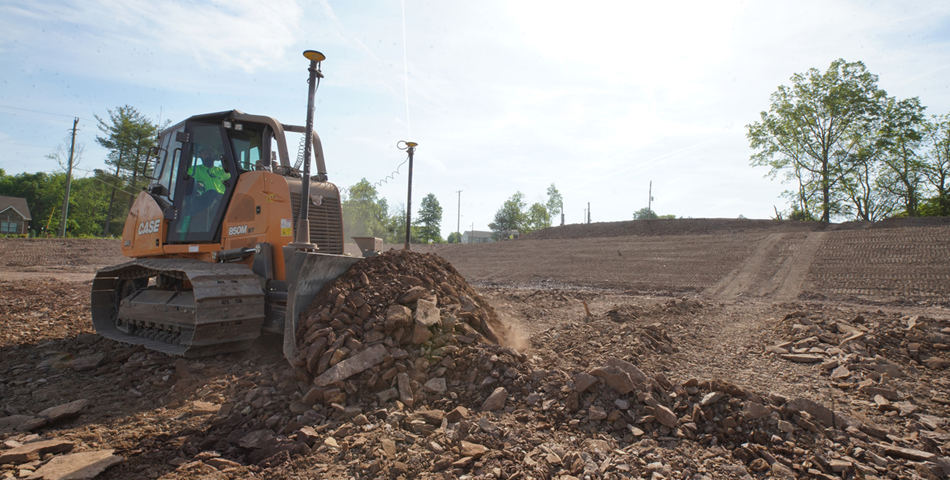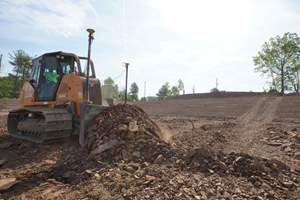By now everyone is familiar with machine control technologies utilized on earthmoving applications. But as the costs continue to drop and the technology continues to advance, make sure you are not one of the contractors who gets left behind.
“There are very few earthmoving applications that won’t benefit from machine control in one way, shape or form” explains Jeremy Dulak, product manager, Case Construction Equipment. “As acceptance and adoption is increasing, the contractors you are bidding against on a regular basis may already be using it to streamline their operations and make their bids more aggressive.”
Before adopting any technology, you need to develop an understanding of what it can do for your operation. In the case of grade control, there are many competing technologies, ranging from indicate only systems to full automation. There are important differences between guidance and automation.
Many of the recent advancements are being made in automation. “The automatic solutions are where true machine control takes place,” explains Synder. “This is where the system actually takes over the hydraulics of the machine and the blade to automate that performance. This is particularly helpful when working in a 3D world and trying to build complex grades and site profiles.” Automation helps level the playing field by elevating the performance of less experienced operators while also improving the performance of your best operators.
A Building Block Approach Makes Tech Accessible
Many systems will allow you to invest in lower cost 2D and using the components as building blocks as you move up to 3D. “It’s important to note that many of the components are the same for 2D, the foundational building blocks are already there” says Synder. “When you are ready, you can easily transition to 3D. 2D grading is machine control at its simplest form, its tools work in two dimensions – plane and slope.” This is accomplished through basic technologies like lasers and sonic tracers.
The capabilities expand as you progress into more advanced systems. “3D is where things get really fun and it allows you to expand beyond working with just a slope or a plane,” says Synder. “These machines can be indicate only, but reach the full potential of machine control when they are automatic. You do need to add some additional geospatial technologies to make it work, such as a GPS or a GNSS receiver or a universal total station. These systems still allow you to do plane and slope work, but really simplify those more complex curves and site plans.
You need to choose the correct technology for your worksite. “2D is great for those jobs that are consistent in nature and are often very simple,” says Nathanial Waldschmidt, product manager, Case Construction Equipment. “If you’re typically working on a single slope away from a fixed point of reference, which is often to ensure proper drainage, then a 2D system is going to be more than adequate. If you are doing driveways or parking lots or simple final grading in residential neighborhoods where all you are doing is making sure the grade is pitching away from the home or building, 2D will work. If you are only creating building pads and doing flat work, 2D will definitely work for you and help you ensure that you have that flat, clean plane that you are looking for.”
If you are going to add more complex work in the future, you may want to look at systems that can be easily adapted to 3D. “As your business grows, you evolve and the solution can grow with you to add on to that the next step,” says Waldschmidt. You can step up the capability of the machine control solution as you grow your business. “3D is for more complex projects.” This includes large infrastructure projects where there are countless points of reference throughout the site that must be hit. It makes contouring and more complex designs considerably easier.
Some 3D systems can perform in both 2D and 3D modes. This is important when you want to shift between simple plane surfaces and more complex 3D designs. “It is important to note that not all manufacturers can offer that solution of scaling back down and operating in a 2D situation,” notes Waldschmidt.
Case provided one example of a Leica Geosystems solution matched with a Case machine that can easily go between 2D and 3D. “A machine that is running 3D, that 3D panel also allows you to turn it into 2D mode,” says Snyder. “You absolutely can switch to 2D, eve though it is a 3D system.” For example, you can replace the GPS antenna that’s on top of a mast with a laser receiver. “Now we are operating that 3D machine in a 2D environment.”
Another consideration for machine control technology is the ability to increase jobsite safety. “Any machine control solution that we have running a 3D panel with the current software, we actually have the ability to put a sensor on a safety vest or on a vehicle, so the operator is aware
Contractor Adds Value for Owners
MacMor Construction was one of the first contractors to take delivery of a [Case] factory fit dozer earlier this year. The company began in July of 2013. “We are a heavy highway construction specialist along with doing site work,” says Bryan Golden, owner. “Basically, we have everything to do with the complete site excavation. We will do clearing, grubbing, site work and then all of the utilities.”
Unknowns are among the trickiest complexities when performing site work. You may think that there is a two-foot layer of shale, and it turns out to be eight feet deep. An open line of communication with the owners helps cope with these surprises. “We try to keep as open line of communication with folks as we can,” notes Golden. “We don’t try to hide anything.” To offset any surprises, MacMor is always on the lookout for different ways owners can save money on projects. “We do some value engineering with them.”
Machine control also provides peace of mind during production. “I’ve seen no issues with this machine on any application we put it on,” says Golden. “It does a great job. Whether you run a three to one or a two to one slope with it, you know you are going to hang on. The ability to track in slopes, everything works very well on it. It doesn’t give me any worries about that machine doing what it is supposed to do.”
Curt Bennink














